外研版高一年级下册英语课件必修二 Unit 6 Earth First (3)(共51张PPT)
文档属性
| 名称 | 外研版高一年级下册英语课件必修二 Unit 6 Earth First (3)(共51张PPT) |  | |
| 格式 | zip | ||
| 文件大小 | 2.2MB | ||
| 资源类型 | 教案 | ||
| 版本资源 | 外研版(2019) | ||
| 科目 | 英语 | ||
| 更新时间 | 2020-05-21 17:50:00 | ||
图片预览

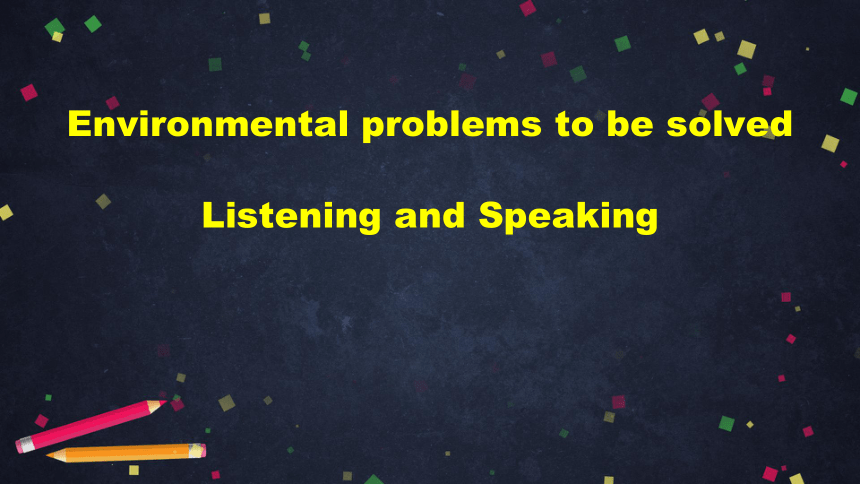
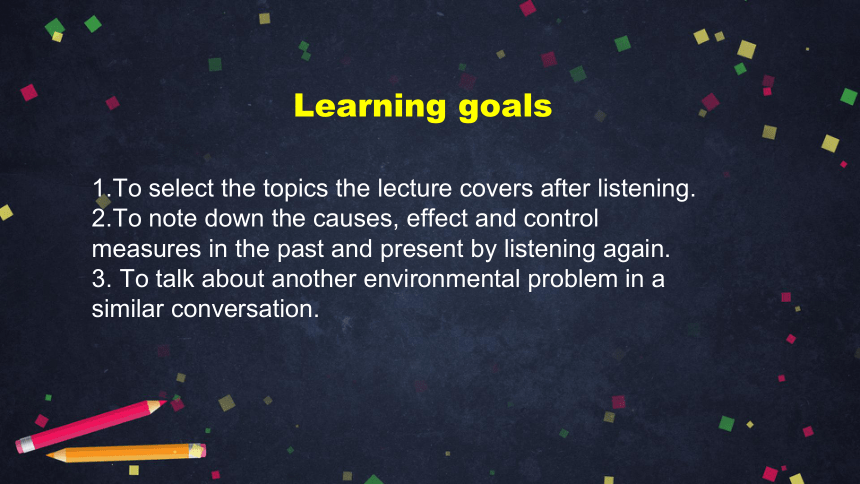

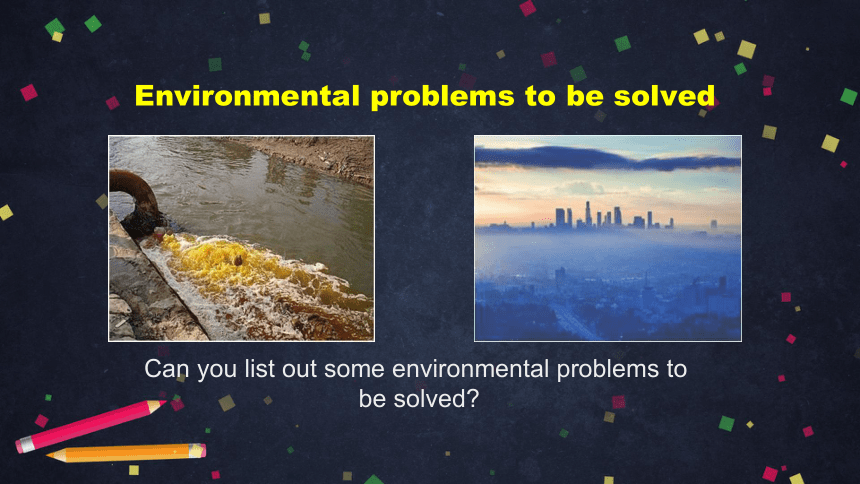
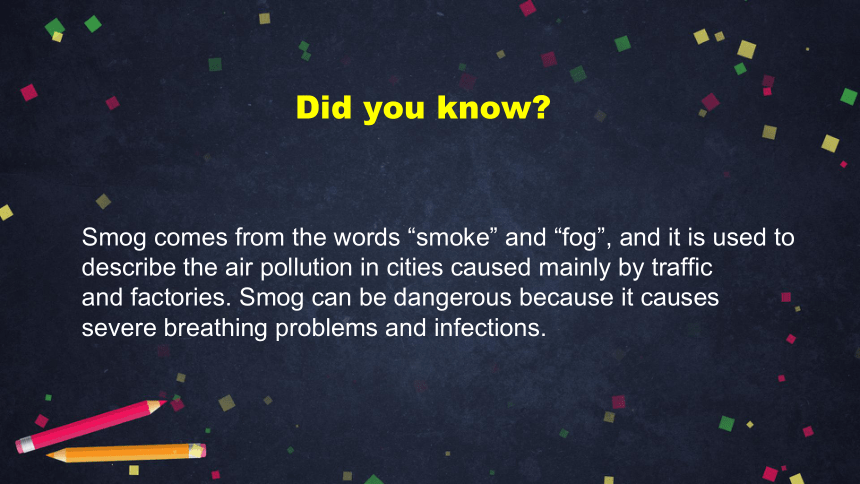
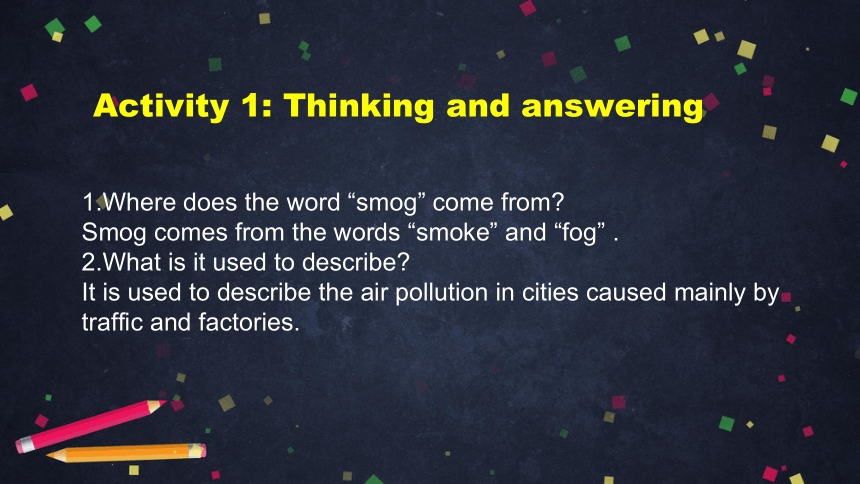
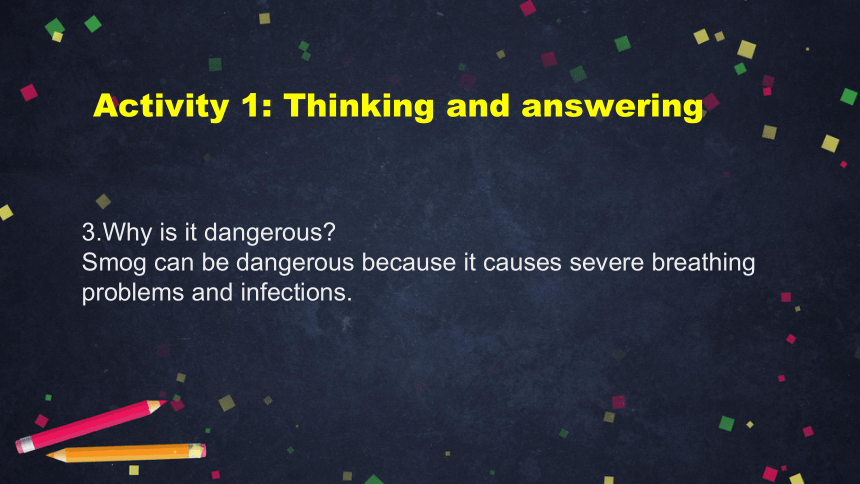
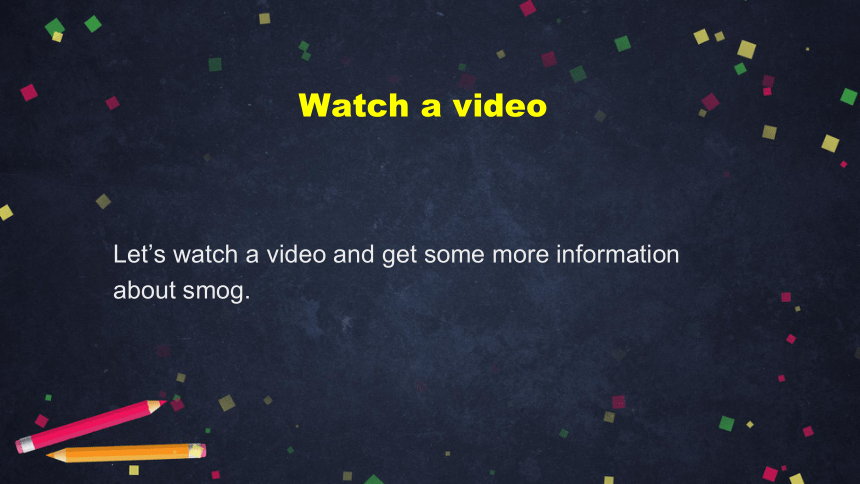
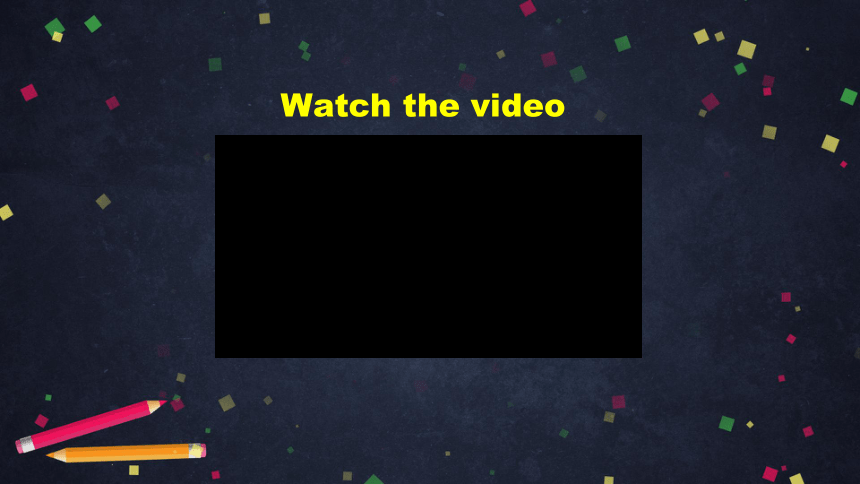
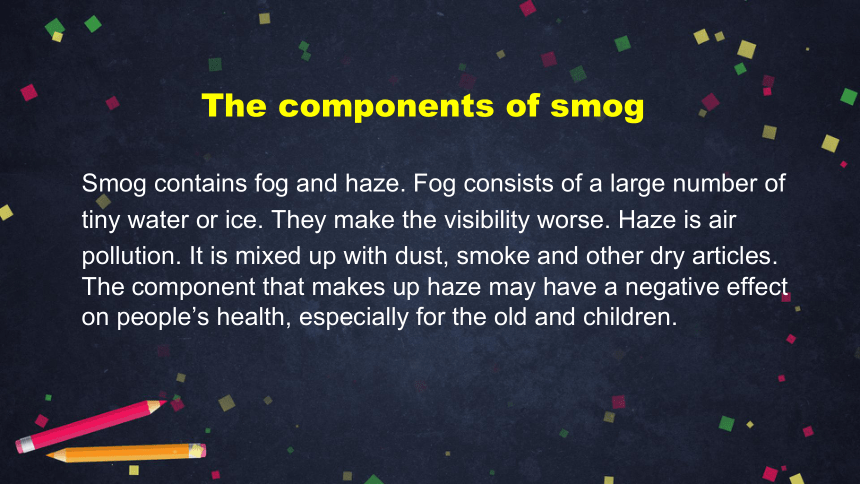
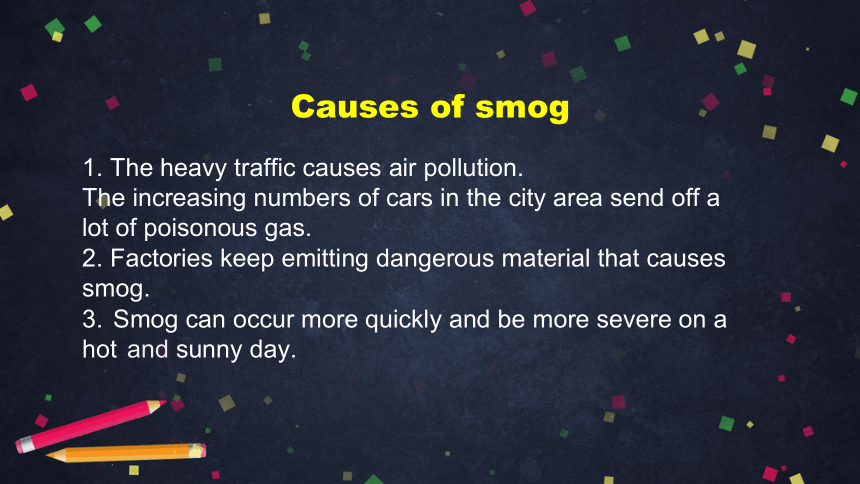
文档简介
(共51张PPT)
必修二 Unit 6 Earth First (3)
高一年级 英语
Environmental problems to be solved
Listening and Speaking
Learning goals
1.To select the topics the lecture covers after listening.
2.To note down the causes, effect and control measures in the past and present by listening again.
3. To talk about another environmental problem in a similar conversation.
Activity 1: Thinking and answering
Environmental problems to be solved
Can you list out some environmental problems to
be solved?
Did you know?
Smog comes from the words “smoke” and “fog”, and it is used to describe the air pollution in cities caused mainly by traffic
and factories. Smog can be dangerous because it causes severe breathing problems and infections.
Activity 1: Thinking and answering
1.Where does the word “smog” come from?
Smog comes from the words “smoke” and “fog” .
2.What is it used to describe?
It is used to describe the air pollution in cities caused mainly by traffic and factories.
Activity 1: Thinking and answering
3.Why is it dangerous?
Smog can be dangerous because it causes severe breathing problems and infections.
Watch a video
Let’s watch a video and get some more information about smog.
Watch the video
The components of smog
Smog contains fog and haze. Fog consists of a large number of tiny water or ice. They make the visibility worse. Haze is air pollution. It is mixed up with dust, smoke and other dry articles.
The component that makes up haze may have a negative effect on people’s health, especially for the old and children.
Causes of smog
1. The heavy traffic causes air pollution.
The increasing numbers of cars in the city area send off a
lot of poisonous gas.
2. Factories keep emitting dangerous material that causes smog.
3. Smog can occur more quickly and be more severe on a hot and sunny day.
Effects of smog on the environment
1. Affect the ecological environment.
Smoggy weather has an important impact on roads, railways, aviation, shipping, power supply system and crop growth.
2. Cause great harm to human health.
Hinder the normal blood circulation.
Cause heart disease and breath-related problems.
Effects of smog on the environment
Increase the possibility of suffering from infectious disease.
3. Affect traffic safety.
Visibility is low.
Traffic congestion is likely to occur.
Traffic accidents occur.
…
Measures to take
1. The government and authorities should enforce laws and regulations to control the emission of polluting gas.
2. Plant more trees to improve the air quality.
3. Limit the numbers of cars on road.
4. Go to school or work with public traffic.
5. Make public speeches to raise people’s awareness.
Activity 2: Reading and predicting
Read the seven topics and predict the topics covered in the lecture. P67
1. What the word “smog” means.
2. When the word “smog” appeared.
3. What caused smog in the past.
Activity 2: Reading and predicting
4. What causes smog now.
5. The effects of smog on the environment.
6. How governments try to reduce smog.
7. What will happen if we don’t reduce smog.
Activity 2: Listening and ticking
Listen to the lecture and tick the topics that are covered in the lecture.
Activity 2: Checking answers
The topics that are covered.
Keys : 1 2 3 4 6
1. What the word “smog” means.
2. When the word “smog” appeared.
3. What caused smog in the past.
4. What causes smog now.
6. How governments try to reduce smog.
Activity 2: Focusing on the topics covered
1. What the word “smog” mean.
It is a kind of air pollution, with smoke and fog.
2. When the word “smog” appeared.
It was first used in the 1900s.
3. What caused smog in the past.
It was a cold winter, so a lot of coal was burned at home and in the factories.
The problem was that there was no wind, so thick smog covered the city.
Activity 2: Focusing on the topics covered
Activity 2: Focusing on the topics covered
4. What causes smog now.
Nowadays, smog still exists, but is produced by chemicals coming from traffic and factories.
6. How governments try to reduce smog.
Factories must follow rules about what chemicals they use.
In some cities, when there’s smog, people have to pay to drive in the city center.
Activity 3: Reading and predicting
Read the slides in activity 8 and predict the main idea.
Activity 3: Listening and completing
Listen to the audio and complete the slides.
Activity 3: Checking answers
Smog in the past
Term created in :1. 1900s
Big problems in London: 2. The Great Smog
in December 1952
Causes of the problem: burning too much coal
and 3. no wind
Activity 3: Checking answers
Smog in the present
Causes of the problem: 4. chemicals coming from traffic and factories
Measures: rules about using 5. chemicals in factories and
6. requirements of paying to drive in
the city center
Activity 3: Answering a question
Q 1. What other measures can you think of to reduce smog?
Activity 3: Answering a question
Q 2. What’s the relationship between the speakers?
A teacher and his students.
Activity 4: Listening and taking notes
Now listen to the lecture again and take notes on the expressions used to interrupt the lecturer politely.
Activity 4: Reading the tapescript
Read the lecture by following the tapescript.
Activity 4: Reading the tapescript
Lecturer: Good evening, everyone, and thank you for coming to today’s talk. I’m Dr Brown and I’m going to talk about air pollution in cities—what we all know as “smog”. Please feel free to stop me if you have any questions. So, first of all, a bit of history. The term “smog” was first used in the 1800s in cities that had problems with smoke and fog.
Activity 4: Reading the tapescript
Student A: Sorry for interrupting, but I believe it was in the 1900s.
Lecturer: Sorry, I made a mistake. You are right. It was in the 1900s. Thank you. London was one of the cities where smog caused big problems. In December 1952, it suffered from “The Great Smog”. It was a very cold winter, so a lot of coal was burned at home and in the factories. The problem was that there was no wind, so thick smog covered the city. Nowadays…
Activity 4: Reading the tapescript
Student B: Excuse me, but can I just ask—did the smog cause any deaths?
Lecturer: I’m afraid so. According to research, about 4000
people are known to have died as a result of the smog, but
that number could be much higher. It was terrible! Nowadays, smog still exists, but is produced by chemicals coming from traffic and factories.
Activity 4: Reading the tapescript
However, governments are taking measures to reduce smog
as much as possible. Now, let’s look at what smog does to our
health…
Student A: If I could just stop you again… Can you give us
examples of these measures?
Lecturer: Well, for example, factories must follow rules about what chemicals they use. In some cities, when there’s smog, people have to pay to drive in the centre. Now, let’s move on
to the impact of smog on our health…
Activity 4: Reading the tapescript
Activity 4: Focusing on expressions
The expressions used to interrupt others politely.
Sorry for interrupting, but…
Excuse me, but can I just ask…
If I could just stop you again…
Activity 4: Making a summary and retelling
Make a summary of the lecture and retell the passage.
Activity 4: Reading the summary
The lecture mainly focuses on “smog”. The term smog was created in the1900s. In December 1952, London suffered from “The Great Smog”. A lot of coal was burned at home and in the factories in the cold winter. Besides, there was no wind. Therefore, thick smog covered the city.
Activity 4: Reading the summary
About 4000 people died as a result of the smog. Nowadays, smog still exists because it is produced by chemicals coming from traffic and factories. To reduce the smog, the governments are taking some measures now to improve the air quality.
Activity 5: Answering the question
Q. What is the proper time to interrupt others politely?
A polite interruption is usually framed as a request for permission to interrupt someone, often starting with “If…”,
“May I …?” or “Can I …?”.
Usually we interrupt someone when they pause for
breath, or during the slight pause between spoken
clauses.
Speaking
Read the materials on page 84 and 87. Make up a new dialogue about recycling by using the required expressions.
Reading the sample dialogue
Student A : Hello. Everyone knows it’ s important to protect the environment. I’m going to talk about recycling. Please feel free to stop me if you have any questions. So first of all, the classification of household waste aims to help people separate different types of waste. This is important because these different types of waste can be disposed of
Reading the sample dialogue
or recycled appropriately and effectively. According to the materials I have collected, household waste can be roughly divided into: food waste, non-recyclable waste, recyclable waste, including paper, glass, plastic and used batteries.
Student B: Sorry to interrupt, but I believe used batteries are usually regarded as non-recyclable waste and should be disposed of separately.
Reading the sample dialogue
Student A: Sorry, I’ve made a mistake. You are right. The
used batteries are non-recyclable waste and should be
disposed of separately. Thank you. China plans to introduce household waste classification and sorting in the first batch
of cities by 2020. Only Beijing, Shanghai, Tianjin and
Chongqing are included in the first batch.
Reading the sample dialogue
Student B: Excuse me. Can I ask another question? You mentioned that only four cities are included in the first batch of cities to introduce household waste classification and sorting. But I remember that apart from these four cities, all capitals of provinces and autonomous regions are also included in the first batch of cities. Is that right?
Reading the sample dialogue
Student A: I am sorry. I’ve made another mistake. You are right. Now, Let’s go back to what I was talking about. The target recycling rate in these cities has been set at 55% by 2020.
Student B: Sorry, but could I just stop you again to check
about the target recycling rate? I am wondering whether
the target recycling rate should be 55% or 35% by 2020.
Reading the sample dialogue
Student A: Well, let me see. Yes, you are right. I am sorry again for making the mistake. Thank you for correcting all my mistakes.
Student B: You are welcome.
Focusing on the useful expressions
Please feel free if you have any questions.
Sorry to interrupt, but …
Sorry, I made a mistake. You are right.
Excuse me. Can I ask another question?
Sorry, but could I just stop you again to check…?
Well, let me see.
I am sorry again for making the mistake.
Making a summary
1. Smog in the past and smog in the present.
2. Expressions used to interrupt others politely.
Homework
Choose one of the tasks to finish.
1. Write a similar conversation to talk about another
environmental problem. Use what you have learnt in this
session.
2. Write a short essay to talk about the present situation of
smog in Beijing and the measures the government has taken.
Thank you!
必修二 Unit 6 Earth First (3)
高一年级 英语
Environmental problems to be solved
Listening and Speaking
Learning goals
1.To select the topics the lecture covers after listening.
2.To note down the causes, effect and control measures in the past and present by listening again.
3. To talk about another environmental problem in a similar conversation.
Activity 1: Thinking and answering
Environmental problems to be solved
Can you list out some environmental problems to
be solved?
Did you know?
Smog comes from the words “smoke” and “fog”, and it is used to describe the air pollution in cities caused mainly by traffic
and factories. Smog can be dangerous because it causes severe breathing problems and infections.
Activity 1: Thinking and answering
1.Where does the word “smog” come from?
Smog comes from the words “smoke” and “fog” .
2.What is it used to describe?
It is used to describe the air pollution in cities caused mainly by traffic and factories.
Activity 1: Thinking and answering
3.Why is it dangerous?
Smog can be dangerous because it causes severe breathing problems and infections.
Watch a video
Let’s watch a video and get some more information about smog.
Watch the video
The components of smog
Smog contains fog and haze. Fog consists of a large number of tiny water or ice. They make the visibility worse. Haze is air pollution. It is mixed up with dust, smoke and other dry articles.
The component that makes up haze may have a negative effect on people’s health, especially for the old and children.
Causes of smog
1. The heavy traffic causes air pollution.
The increasing numbers of cars in the city area send off a
lot of poisonous gas.
2. Factories keep emitting dangerous material that causes smog.
3. Smog can occur more quickly and be more severe on a hot and sunny day.
Effects of smog on the environment
1. Affect the ecological environment.
Smoggy weather has an important impact on roads, railways, aviation, shipping, power supply system and crop growth.
2. Cause great harm to human health.
Hinder the normal blood circulation.
Cause heart disease and breath-related problems.
Effects of smog on the environment
Increase the possibility of suffering from infectious disease.
3. Affect traffic safety.
Visibility is low.
Traffic congestion is likely to occur.
Traffic accidents occur.
…
Measures to take
1. The government and authorities should enforce laws and regulations to control the emission of polluting gas.
2. Plant more trees to improve the air quality.
3. Limit the numbers of cars on road.
4. Go to school or work with public traffic.
5. Make public speeches to raise people’s awareness.
Activity 2: Reading and predicting
Read the seven topics and predict the topics covered in the lecture. P67
1. What the word “smog” means.
2. When the word “smog” appeared.
3. What caused smog in the past.
Activity 2: Reading and predicting
4. What causes smog now.
5. The effects of smog on the environment.
6. How governments try to reduce smog.
7. What will happen if we don’t reduce smog.
Activity 2: Listening and ticking
Listen to the lecture and tick the topics that are covered in the lecture.
Activity 2: Checking answers
The topics that are covered.
Keys : 1 2 3 4 6
1. What the word “smog” means.
2. When the word “smog” appeared.
3. What caused smog in the past.
4. What causes smog now.
6. How governments try to reduce smog.
Activity 2: Focusing on the topics covered
1. What the word “smog” mean.
It is a kind of air pollution, with smoke and fog.
2. When the word “smog” appeared.
It was first used in the 1900s.
3. What caused smog in the past.
It was a cold winter, so a lot of coal was burned at home and in the factories.
The problem was that there was no wind, so thick smog covered the city.
Activity 2: Focusing on the topics covered
Activity 2: Focusing on the topics covered
4. What causes smog now.
Nowadays, smog still exists, but is produced by chemicals coming from traffic and factories.
6. How governments try to reduce smog.
Factories must follow rules about what chemicals they use.
In some cities, when there’s smog, people have to pay to drive in the city center.
Activity 3: Reading and predicting
Read the slides in activity 8 and predict the main idea.
Activity 3: Listening and completing
Listen to the audio and complete the slides.
Activity 3: Checking answers
Smog in the past
Term created in :1. 1900s
Big problems in London: 2. The Great Smog
in December 1952
Causes of the problem: burning too much coal
and 3. no wind
Activity 3: Checking answers
Smog in the present
Causes of the problem: 4. chemicals coming from traffic and factories
Measures: rules about using 5. chemicals in factories and
6. requirements of paying to drive in
the city center
Activity 3: Answering a question
Q 1. What other measures can you think of to reduce smog?
Activity 3: Answering a question
Q 2. What’s the relationship between the speakers?
A teacher and his students.
Activity 4: Listening and taking notes
Now listen to the lecture again and take notes on the expressions used to interrupt the lecturer politely.
Activity 4: Reading the tapescript
Read the lecture by following the tapescript.
Activity 4: Reading the tapescript
Lecturer: Good evening, everyone, and thank you for coming to today’s talk. I’m Dr Brown and I’m going to talk about air pollution in cities—what we all know as “smog”. Please feel free to stop me if you have any questions. So, first of all, a bit of history. The term “smog” was first used in the 1800s in cities that had problems with smoke and fog.
Activity 4: Reading the tapescript
Student A: Sorry for interrupting, but I believe it was in the 1900s.
Lecturer: Sorry, I made a mistake. You are right. It was in the 1900s. Thank you. London was one of the cities where smog caused big problems. In December 1952, it suffered from “The Great Smog”. It was a very cold winter, so a lot of coal was burned at home and in the factories. The problem was that there was no wind, so thick smog covered the city. Nowadays…
Activity 4: Reading the tapescript
Student B: Excuse me, but can I just ask—did the smog cause any deaths?
Lecturer: I’m afraid so. According to research, about 4000
people are known to have died as a result of the smog, but
that number could be much higher. It was terrible! Nowadays, smog still exists, but is produced by chemicals coming from traffic and factories.
Activity 4: Reading the tapescript
However, governments are taking measures to reduce smog
as much as possible. Now, let’s look at what smog does to our
health…
Student A: If I could just stop you again… Can you give us
examples of these measures?
Lecturer: Well, for example, factories must follow rules about what chemicals they use. In some cities, when there’s smog, people have to pay to drive in the centre. Now, let’s move on
to the impact of smog on our health…
Activity 4: Reading the tapescript
Activity 4: Focusing on expressions
The expressions used to interrupt others politely.
Sorry for interrupting, but…
Excuse me, but can I just ask…
If I could just stop you again…
Activity 4: Making a summary and retelling
Make a summary of the lecture and retell the passage.
Activity 4: Reading the summary
The lecture mainly focuses on “smog”. The term smog was created in the1900s. In December 1952, London suffered from “The Great Smog”. A lot of coal was burned at home and in the factories in the cold winter. Besides, there was no wind. Therefore, thick smog covered the city.
Activity 4: Reading the summary
About 4000 people died as a result of the smog. Nowadays, smog still exists because it is produced by chemicals coming from traffic and factories. To reduce the smog, the governments are taking some measures now to improve the air quality.
Activity 5: Answering the question
Q. What is the proper time to interrupt others politely?
A polite interruption is usually framed as a request for permission to interrupt someone, often starting with “If…”,
“May I …?” or “Can I …?”.
Usually we interrupt someone when they pause for
breath, or during the slight pause between spoken
clauses.
Speaking
Read the materials on page 84 and 87. Make up a new dialogue about recycling by using the required expressions.
Reading the sample dialogue
Student A : Hello. Everyone knows it’ s important to protect the environment. I’m going to talk about recycling. Please feel free to stop me if you have any questions. So first of all, the classification of household waste aims to help people separate different types of waste. This is important because these different types of waste can be disposed of
Reading the sample dialogue
or recycled appropriately and effectively. According to the materials I have collected, household waste can be roughly divided into: food waste, non-recyclable waste, recyclable waste, including paper, glass, plastic and used batteries.
Student B: Sorry to interrupt, but I believe used batteries are usually regarded as non-recyclable waste and should be disposed of separately.
Reading the sample dialogue
Student A: Sorry, I’ve made a mistake. You are right. The
used batteries are non-recyclable waste and should be
disposed of separately. Thank you. China plans to introduce household waste classification and sorting in the first batch
of cities by 2020. Only Beijing, Shanghai, Tianjin and
Chongqing are included in the first batch.
Reading the sample dialogue
Student B: Excuse me. Can I ask another question? You mentioned that only four cities are included in the first batch of cities to introduce household waste classification and sorting. But I remember that apart from these four cities, all capitals of provinces and autonomous regions are also included in the first batch of cities. Is that right?
Reading the sample dialogue
Student A: I am sorry. I’ve made another mistake. You are right. Now, Let’s go back to what I was talking about. The target recycling rate in these cities has been set at 55% by 2020.
Student B: Sorry, but could I just stop you again to check
about the target recycling rate? I am wondering whether
the target recycling rate should be 55% or 35% by 2020.
Reading the sample dialogue
Student A: Well, let me see. Yes, you are right. I am sorry again for making the mistake. Thank you for correcting all my mistakes.
Student B: You are welcome.
Focusing on the useful expressions
Please feel free if you have any questions.
Sorry to interrupt, but …
Sorry, I made a mistake. You are right.
Excuse me. Can I ask another question?
Sorry, but could I just stop you again to check…?
Well, let me see.
I am sorry again for making the mistake.
Making a summary
1. Smog in the past and smog in the present.
2. Expressions used to interrupt others politely.
Homework
Choose one of the tasks to finish.
1. Write a similar conversation to talk about another
environmental problem. Use what you have learnt in this
session.
2. Write a short essay to talk about the present situation of
smog in Beijing and the measures the government has taken.
Thank you!
